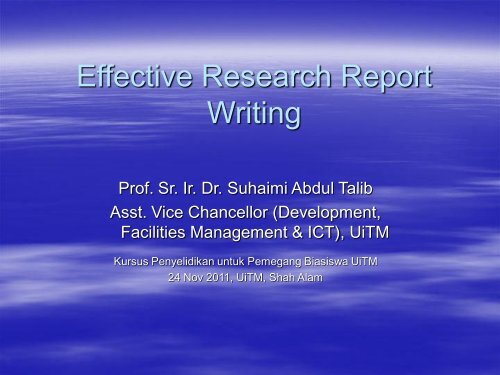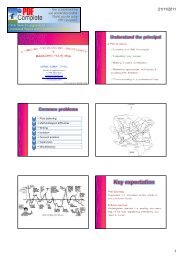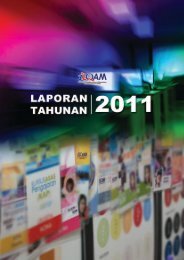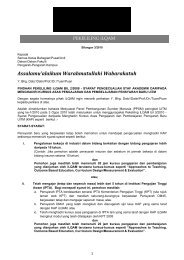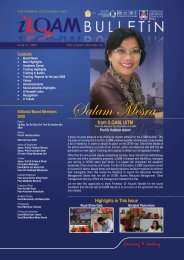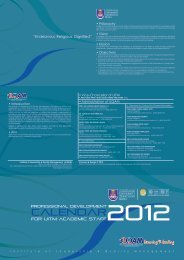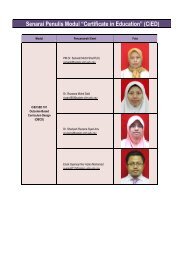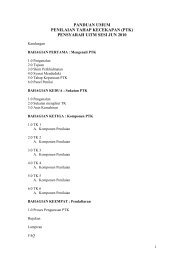Thesis - UiTM
Thesis - UiTM
Thesis - UiTM
You also want an ePaper? Increase the reach of your titles
YUMPU automatically turns print PDFs into web optimized ePapers that Google loves.
Effective Research Report<br />
Writing<br />
Prof. Sr. Ir. Dr. Suhaimi Abdul Talib<br />
Asst. Vice Chancellor (Development,<br />
Facilities Management & ICT), <strong>UiTM</strong><br />
Kursus Penyelidikan untuk Pemegang Biasiswa <strong>UiTM</strong><br />
24 Nov 2011, <strong>UiTM</strong>, Shah Alam
What is a <strong>Thesis</strong><br />
• A theory maintained in argument.<br />
• Unproved statement put forward as a basis<br />
in an argument.<br />
• A dissertation resulting from original<br />
research, submitted by a candidate for a<br />
degree.
DIFFERENCE BETWEEN AN M.Sc. THESIS<br />
and A Ph.D. THESIS
Bloom’s Taxonomy of Educational<br />
Objectives: Cognitive Domain<br />
Creating (Synthesis)<br />
Evaluating (Evaluation)<br />
Analyzing (Analysis)<br />
Applying (Application)<br />
Understanding (Comprehension)<br />
Remembering (Knowledge)<br />
Design, plan, create, formulate<br />
Make criteria-based judgments<br />
(choose, prioritize, rate, critique)<br />
Explain, interpret, predict the<br />
behavior of a system<br />
Apply known procedures to novel<br />
problems<br />
Explain, interpret, classify, compare<br />
terms, observations, & concepts<br />
Recall facts & definitions, replicate<br />
known solution procedures
Characteristics of a thesis<br />
• Written for a very small group<br />
of audience<br />
• Very focus and specific<br />
• Convey clear and detailed<br />
message without having to<br />
interact with the author<br />
• Is one of the many pictures<br />
on a wall in a gallery<br />
• Not just a degree – character<br />
building
Characteristics of a good thesis<br />
• The material is original.<br />
• The title, abstract and keywords accurately reflect<br />
the content of the thesis<br />
• -The objectives of the study are clearly stated.<br />
• -Parameters to be determined and method to be<br />
used are clearly defined.<br />
• -The results are well presented and interpreted.<br />
• -There are no inconsistencies in tables, figures<br />
and references.<br />
• -The conclusions are logical and clearly stated.<br />
• -Complete and comprehensive list of references
Structure of a thesis – EU/Japan<br />
• Executive Summary<br />
• Papers published as a result of the Ph.D.<br />
Investigation
Structure of a thesis – Traditional UK<br />
• Preliminaries<br />
• Introduction<br />
• Literature Review<br />
• Research Methodology<br />
• Results and Discussions<br />
• Conclusions<br />
• Recommendations<br />
• References<br />
• Appendices
Introduction – Research Direction<br />
• Brief Background<br />
• Problem Statement<br />
• Goal and Objectives<br />
• Scope of work and<br />
Brief Methodology<br />
THIS IS YOUR<br />
COMPASS
Brief Background<br />
• Chart– what others have done
Work reported in Literature<br />
In-sewer processes<br />
study<br />
Characterisation of wastewater<br />
Raunkjaer (1993)<br />
Bjerre et al. (1995)<br />
Vollertsen and Hvitved-Jacobsen<br />
(2002)<br />
Modelling processes in sewer<br />
networks<br />
AEROSEPT (Matos, 1992)<br />
Mousetrap (Garsdal et al., 1995)<br />
WATS (Tanaka, 1998)<br />
ASM3 (Huisman, 2001)<br />
Aerobic<br />
Anoxic<br />
Anaerobic<br />
Bulk water<br />
Bjerre et al.<br />
(1995)<br />
Almeida (1999)<br />
Biofilm<br />
Raunkjaer . (1993)<br />
Bjerre et al. (1998)<br />
Huisman (2001)<br />
Bulk water<br />
Tanaka and Hvitved-Jacobsen<br />
(1998)<br />
Haaning et al. (in progress)<br />
Pilot Scale<br />
Tanaka et al.<br />
(1998)<br />
Sediment<br />
Vollertsen et al.<br />
(1998)<br />
Air-water<br />
interface<br />
Jensen (1994)<br />
Bulk water<br />
Abdul-Talib et al.<br />
(2002)<br />
Pilot Scale<br />
Æsøy et al. (1997)<br />
Air-water Interface<br />
Yongsiri et al. (2002)
Studies on In-sewer Processes<br />
In-sewer Processes<br />
study<br />
Characterisation<br />
of wastewater<br />
Study<br />
on kinetics<br />
Modelling processes<br />
in sewer networks<br />
Aerobic<br />
Anoxic<br />
Anaerobic<br />
Bulk water Biofilm Sediment Air-water interface
Problem Statement<br />
• What is the present<br />
situation<br />
• What‟s wrong with it<br />
• What needs to be<br />
done
Integrated Wastewater<br />
Treatment System
The sewer sub-system
Integrated Wastewater<br />
Treatment System
Work reported in Literature<br />
In-sewer processes<br />
study<br />
Characterisation of wastewater<br />
Raunkjaer (1993)<br />
Bjerre et al. (1995)<br />
Vollertsen and Hvitved-Jacobsen<br />
(2002)<br />
Modelling processes in sewer<br />
networks<br />
AEROSEPT (Matos, 1992)<br />
Mousetrap (Garsdal et al., 1995)<br />
WATS (Tanaka, 1998)<br />
ASM3 (Huisman, 2001)<br />
Aerobic<br />
Anoxic<br />
Anaerobic<br />
Bulk water<br />
Bjerre et al.<br />
(1995)<br />
Almeida (1999)<br />
Biofilm<br />
Raunkjaer . (1993)<br />
Bjerre et al. (1998)<br />
Huisman (2001)<br />
Bulk water<br />
Tanaka and Hvitved-Jacobsen<br />
(1998)<br />
Haaning et al. (in progress)<br />
Pilot Scale<br />
Tanaka et al.<br />
(1998)<br />
Sediment<br />
Vollertsen et al.<br />
(1998)<br />
Air-water<br />
interface<br />
Jensen (1994)<br />
Bulk water<br />
Abdul-Talib et al.<br />
(2002)<br />
Pilot Scale<br />
Æsøy et al. (1997)<br />
Air-water Interface<br />
Yongsiri et al. (2002)
Goal and Objectives –<br />
The Need To Do Research Arise From<br />
1. Establishing the „truth‟<br />
2. Eliminate falsehood as regards to facts, history<br />
and performances<br />
3. Evaluating the soundness of theory<br />
4. Solve practical problems<br />
5. Extend and produce good knowledge<br />
6. Develop new policies, products, practices etc.
Goal and Objectives<br />
• Provide a general statement of a big picture<br />
• Specific objectives should be SMART<br />
• To…..followed by a verb<br />
• To establish…<br />
• To model…<br />
• To compare…<br />
• To evaluate<br />
• Outcome to measure the objectives
Objectives<br />
• Most important of the whole document<br />
• Will determine : scope of work<br />
• methodology<br />
• conclusions
Scope of work<br />
• What is involved – laboratory, field,<br />
modelling, etc.<br />
• Where the study is to be conducted<br />
• When and how long
Scope of work<br />
• Important to show that each item in the<br />
scope contributes to your stated<br />
objectives.<br />
• Work that will not lead to<br />
achievement of objectives<br />
– inefficient planning
Literature Review<br />
• Introduce problem on global/national scale.<br />
• Problems associated with the issue in Malaysia.<br />
• Institutional/Management/Regulatory aspects.<br />
• Theoretical aspects<br />
• Specific related studies –<br />
comparison.<br />
• Gap analysis and<br />
justification.
Literature Review<br />
• Cover a decent duration<br />
• Variety of reference types<br />
• Review – not just reporting<br />
• Review based on themes (not chronology)<br />
• Show ability to comprehend, analyse,<br />
synthesize and evaluate<br />
• Provide original opinion with sound<br />
reasoning
Literature Review<br />
• Fundamental flaws in published work<br />
• The use of inappropriate equipment<br />
• Flaws in assumption<br />
• Ability to screen reported data-resultsconclusions<br />
• Do not have Tables and Figures without<br />
commenting on them<br />
• Conclusions not supported by data
Literature Review<br />
• Literature review is not reporting one<br />
article after the other.<br />
• Ensure that citation and reference are<br />
correctly written (using correct format<br />
especially the use of et al.)<br />
• Ensure that citation and references are<br />
consistent.
Literature Review<br />
• Clearly indicate that<br />
there is a gap in the<br />
present body of<br />
knowledge – this is<br />
why you are doing<br />
the work<br />
• Be honest and<br />
ethical
Plagiarism<br />
• Copying directly – verbatim<br />
• Paraphrasing without citation<br />
• Writing your own sentences without citation
Methodology
Methodology<br />
• Description on methodology:<br />
– What is being measured<br />
– What instrument is used<br />
– What are the specs of the instruments<br />
– Ensure that it is not written as a lab sheet,<br />
describe what HAS been done, NOT what WILL<br />
be done OR SHOULD be done<br />
– Use past tense
Research Methodology<br />
• Recall your objectives and scope of work<br />
• This is where detail procedures on how you<br />
do things is being described<br />
• Describe the location of study<br />
• Describe the sampling method<br />
• Type of data to be collected from<br />
experiments and number of samples
Research Methodology<br />
• Instrumentation – individual piece<br />
• Experimental set up<br />
• Experimental procedures<br />
Provide schematics
NUR TESTS FOR RATES AND K NO3<br />
Nitrogen<br />
gas<br />
Temperature<br />
bath fixed at<br />
27 or 20C Reactor<br />
A<br />
valve<br />
Reactor<br />
B<br />
valve<br />
Reactor<br />
C<br />
valve<br />
Reactor<br />
D<br />
valve<br />
pump
AEROBIC REACTORS – OUR TESTS (COD-Fractions)<br />
Data logger for<br />
recording DO<br />
Air pump<br />
Spilling chamber<br />
during aeration cycle<br />
Oxygen<br />
probe<br />
Auto opening<br />
mechanism during<br />
aeration cycle<br />
Cooling/ heating<br />
water outlet<br />
DO probe connected to<br />
computer for data<br />
logging<br />
Cooling/ heating<br />
water inlet<br />
Magnetic<br />
stirrer<br />
Inlets for<br />
aeration<br />
Magnetic stirrer<br />
Malaysia<br />
Denmark
Research Methodology<br />
Standard Method<br />
provide reference<br />
New Method<br />
describe in detail<br />
Non-standard Method<br />
taken from literature<br />
describe in detail and<br />
provide reference
Research Methodology<br />
• Final checks:<br />
• Level 1 : Will someone be able to<br />
perform these experiments<br />
without consulting me<br />
Level 2 : Get someone to read and ask<br />
for comments
Results and Discussion<br />
This Chapter must reflect:<br />
Purpose<br />
Rigor<br />
Testability<br />
Replicability<br />
Precision and Confidence<br />
Objectivity<br />
Generalization
Results and Discussion<br />
• Arrange sequentially so that data analysis<br />
and results will build your case towards<br />
fulfilling the objectives
• Ensure that there is a corresponding<br />
“visible” result for each objective. This can<br />
be in the form of a flowchart, table or<br />
graphs.<br />
• Ensure that findings are consistent with<br />
results and conclusions are consistent with<br />
objectives.
Results and Discussion<br />
• The use of Graphs and Tables. Show them<br />
as soon as they are mentioned in text<br />
• Discuss these graphs and tables
Results and Discussions<br />
• Do not limit to<br />
relating principal<br />
variables only.<br />
• Graph with high<br />
scatter can be very<br />
useful.<br />
• Do not limit to what<br />
EXCEL can do.
Results and Discussions<br />
• Compare and Evaluate your results with<br />
those found in literature<br />
• Useful to establish indices – normalize your<br />
data<br />
• Highlight your results using scientific<br />
explanation – physics, chemistry, biology
Contribution<br />
- evaluation of the importance of your findings<br />
to the development of the discipline<br />
- significance of your analysis<br />
- limitations<br />
- new perspectives
Contribution<br />
• Original<br />
• Impact on<br />
mankind and its<br />
environment
Conclusion<br />
Address findings related to your objectives<br />
- State that they have been<br />
achieved<br />
- Attach numerical values that<br />
comes from your findings<br />
- Describe the type of behaviour<br />
that was observed<br />
- Highlight your contributions
• Provide 5 – 6<br />
possible areas of<br />
extensions<br />
Recommendations
References<br />
• Include works from leading experts.<br />
• Include most recent findings on the subject.<br />
• Important to keep your articles and<br />
reference list systematically.<br />
• Reference list must be consistent with<br />
citation.<br />
• Follow whatever format and rules that has<br />
been given by the University – no matter<br />
how inconvenient.
References<br />
• Note on references to be cited.<br />
• Journals<br />
• Authoritative as articles are reviewed by experts prior<br />
• to publication<br />
• Publication takes quite while<br />
• Publication over a duration of 1-3 years are relevant<br />
• Proceedings<br />
• Most recent findings<br />
• Need to exercise caution as articles are not thoroughly<br />
• reviewed.<br />
• May contain inconsistencies<br />
• May contain serious fundamental errors<br />
• Publication over duration of 1-5 years are relevant
Some Reminders
All Sections<br />
• Ensure that all sections begin with some<br />
text.<br />
• Ensure that passive voice is used. Do not<br />
use we, our, my, I, you, etc.
All Sections<br />
• Ensure that all Figures and Tables used in<br />
reports are introduced, mentioned and<br />
discussed in the text.<br />
• All Figures and Tables should be given<br />
appropriate and correct captions.
All Sections<br />
• Do not use locater words such as “above “or<br />
“below” for Figures or Tables. Number<br />
Figures/ Tables appropriately and refer to<br />
them by this numbering system.
All Sections<br />
• Introduce the “factors” before listing<br />
them in properly numbered system<br />
either a, b, c...... or i, ii, iii.<br />
• Do not use bullets;<br />
• Ensure consistency in explaining<br />
factors introduced in text.
All Sections<br />
• Advise students to use spell-check<br />
• Resubmission together with the previous<br />
corrected submission.
Current Trends in Research<br />
•Multi (inter) –disciplinary<br />
•Global Collaboration<br />
•Industry-University Collaboration<br />
•Increase in Qualitative research<br />
•Increase in ethical issues<br />
•Increase in public demand for<br />
accountability and benefits of research
Characteristics of a good<br />
researcher….<br />
Creative & Inquisitive mind<br />
Intelligent - Understand the problem<br />
Persistence- progress based on trial & error<br />
Patience – repeat tests & experiments<br />
Humility – read & study what others have<br />
done
Characteristics of a good<br />
researcher….<br />
•Ability to expect outcome<br />
•Ability to deduce results<br />
•Ability to conclude<br />
•Ability to expand existing research<br />
•Ability of produce reports and technical<br />
papers<br />
•Ability to make effective oral presentations
Thank you


